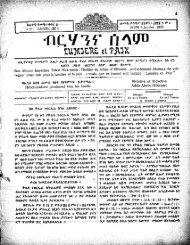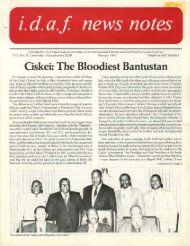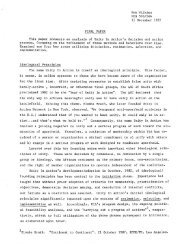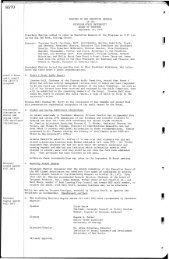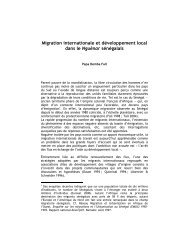the churches and southern africa - KORA
the churches and southern africa - KORA
the churches and southern africa - KORA
You also want an ePaper? Increase the reach of your titles
YUMPU automatically turns print PDFs into web optimized ePapers that Google loves.
INSIDE<br />
SOUTH<br />
AFRICA<br />
SOUTH AFRICA's "BANTU HOMELANDS"<br />
Zulus Dem<strong>and</strong> More L<strong>and</strong><br />
The White South African Government has announced<br />
plans to consolidate Zulul<strong>and</strong> in terms of <strong>the</strong> 1936 Trust<br />
<strong>and</strong> L<strong>and</strong> Act. At present, Zulul<strong>and</strong> is made up of 157<br />
"Black Spots" <strong>and</strong> 63 "Zulu areas." These are to be<br />
transformed into "five large pieces of homel<strong>and</strong> <strong>and</strong> one<br />
small piece." This will involve <strong>the</strong> exchange of 668,000<br />
hectare of "white owned l<strong>and</strong> for 554,000 hectare of<br />
Black-owned <strong>and</strong> Bantu Trust L<strong>and</strong>." This proposal has<br />
been announced by Mr. Raubepheimer, Deputy Minister<br />
of Bantu Administration. He made it very clear that <strong>the</strong><br />
proposal "in no way reflected a final decision by <strong>the</strong><br />
Government." He said that "White farmers should not<br />
have to give up more l<strong>and</strong> for <strong>the</strong> consolidation of <strong>the</strong><br />
Zulu homel<strong>and</strong> until that l<strong>and</strong> already owned by <strong>the</strong><br />
Africans was used to its fullest agricultural advantage."<br />
(Star, Johannesburg, June 17, 1972)<br />
According to <strong>the</strong> 1936. Trust <strong>and</strong> L<strong>and</strong> Act, 13% of<br />
South Africa's l<strong>and</strong> will be for <strong>the</strong> Africans, who comprise<br />
almost 80% of <strong>the</strong> population. The KwaZulu Government<br />
has rejected <strong>the</strong> Government's consolidation plan. Chief<br />
Minister Gatsha Bu<strong>the</strong>lezi made <strong>the</strong> following statement:<br />
"We cannot see ourselves being used in this way in<br />
covering up naked <strong>and</strong> outright White domination....<br />
"We find it unacceptable that we should not have been<br />
involved at all as Black people in <strong>the</strong> preparing of <strong>the</strong><br />
draft even in terms of <strong>the</strong> 1936 act." (Star of<br />
Johannesburg, June 10, 1972) In ano<strong>the</strong>r statement,<br />
Bu<strong>the</strong>lezi asked whe<strong>the</strong>r Zulu development would at most<br />
mean that Zulul<strong>and</strong> would merely continue to be a vast<br />
labor farm for White South Africa. He stated that at <strong>the</strong><br />
present time this was what <strong>the</strong> Black homel<strong>and</strong>s are.<br />
(R<strong>and</strong> Daily Mail, Johannesburg, June 16, 1972)<br />
Tswana Homel<strong>and</strong> Established<br />
On June 1, 1972 <strong>the</strong> Tswana homel<strong>and</strong> became <strong>the</strong><br />
"Self-Governing" territory of Bophuthatswana. Lukas<br />
Mangope became Chief Minister, <strong>and</strong> he has spoken out<br />
strongly on behalf of "separate development." He said<br />
that separate development was <strong>the</strong> only policy that would<br />
give <strong>the</strong> Tswana people <strong>the</strong> final say over <strong>the</strong>ir own<br />
affairs. His territory will rely, according to Mangope, on<br />
mining houses <strong>and</strong> o<strong>the</strong>r private organizations to help in<br />
<strong>the</strong> development of its rich mineral <strong>and</strong> agricultural<br />
potential. He gave toe assurance tha-t-no company need<br />
fear any interference in its industrial activities.<br />
The territory of Bophuthatswana consists of 53,685<br />
square kilometers of l<strong>and</strong> scattered across <strong>the</strong> Transvaal<br />
<strong>and</strong> <strong>the</strong> Nor<strong>the</strong>rn Cape. Plans have been made to<br />
consolidate <strong>the</strong> 20 scattered areas into only five areas.<br />
(Star, Johannesburg, July 8, 1972) Mangope is chief of,,<br />
1,600,000 Tswana people, only 600,000 of whom live<br />
within <strong>the</strong> boundaries of <strong>the</strong> homel<strong>and</strong>. (Star,<br />
Johannesburg, June 10, 1972) Already he has been widely<br />
criticized by urban Tswana for his statements in support<br />
of "<strong>the</strong> positive aspects of separate development."<br />
Typical of <strong>the</strong> criticism is this statement: "Chief<br />
Mangope's unfortunate public statements came as a big<br />
shock to Itany of Us. The impression likely to be<br />
created ... will be that all Tswana in South Africa are in<br />
favor of separate development <strong>and</strong> prefer <strong>the</strong> Nationalists<br />
to ei<strong>the</strong>r <strong>the</strong> Progressives or <strong>the</strong> United Party. This would<br />
be misleading." (Star, Johannesburg, July 1, 1972)<br />
Opposition to Mangope has already consolidated in <strong>the</strong><br />
creation of an opposition party, led by Chief Ted Pilane.<br />
Pilane is credited with having done <strong>the</strong> spadework for <strong>the</strong><br />
Tswana Territorial Authority <strong>and</strong> his supporters say <strong>the</strong>y<br />
cannot uoderst<strong>and</strong> why he did not become <strong>the</strong> first Chief<br />
Minister instead of Mangope. (Star, Johannesburg, Aug. 5,<br />
1972)<br />
Ciskei Homel<strong>and</strong> Established<br />
On August 1, 1972 <strong>the</strong> Ciskei became <strong>the</strong> third<br />
"self-governing" Bantustan, following <strong>the</strong> Transkei <strong>and</strong><br />
<strong>the</strong> Tswana homel<strong>and</strong>. The new Ciskeian Constitution<br />
Proclamation 1972 provides for <strong>the</strong> reconstitution of <strong>the</strong><br />
legislative assembly to have a total membership of 50-<strong>the</strong><br />
paramount chief of <strong>the</strong> Amarrabe, <strong>the</strong> present 29 chiefs<br />
of <strong>the</strong> various tribes, <strong>and</strong> 20 members elected by<br />
Ciskeians with franchise rights. (Star, Johannesburg, July<br />
29, 1972)<br />
The patchwork pieces of African-owned l<strong>and</strong> °in Natal<br />
which toge<strong>the</strong>r form <strong>the</strong> homel<strong>and</strong> of <strong>the</strong> Zulu nation.



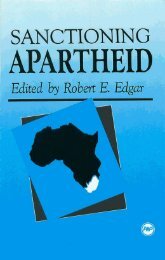
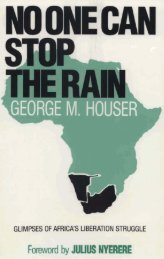

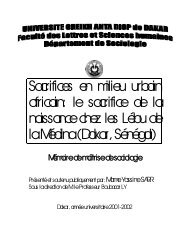
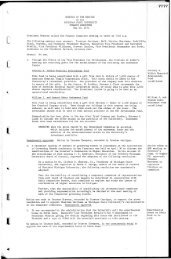

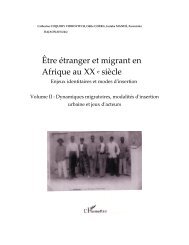
![Synthèse [6] DEFALL..INSTRAW.pdf - Matrix](https://img.yumpu.com/17880734/1/190x245/synthese-6-defallinstrawpdf-matrix.jpg?quality=85)
